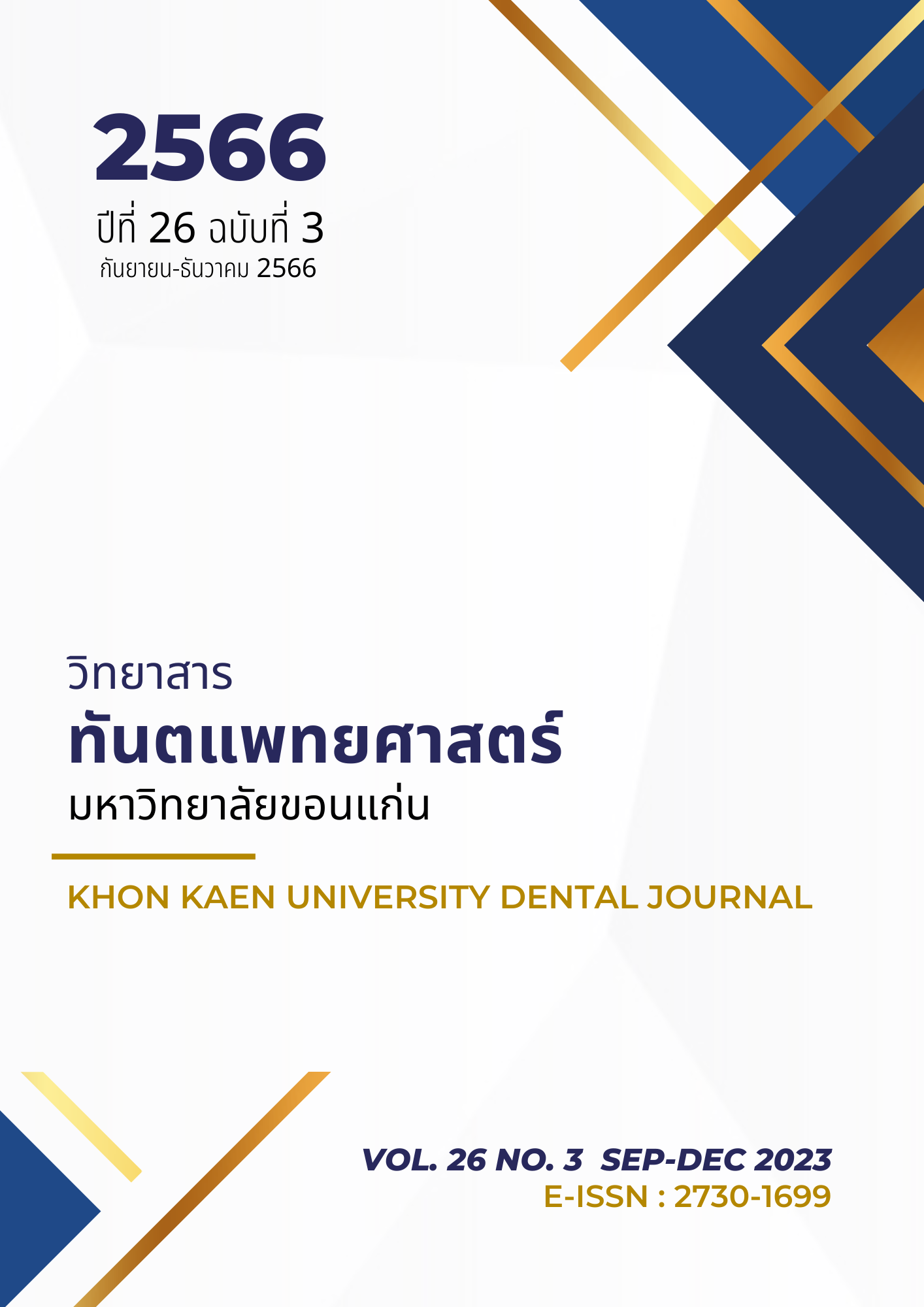Accuracy Assessment of a Three-Dimensional Virtual Soft Tissue Simulation System in Predicting Surgery Outcome for Class III Patients
Main Article Content
Abstract
Current orthodontic theory and practice are primarily based on improving facial esthetic appearance. Patients with exaggerated soft tissue features originating from severe skeletal discrepancies are appropriate candidates for surgical-orthodontic treatment. Three-dimensional simulation of soft tissue changes prior to actual operation is available as a prediction method to estimate possible treatment outcomes, although the accuracy of such methods remains ambiguous. The objective of this study was to assess the accuracy of virtual soft tissue simulation performed using a 3D system. Fifteen patients with skeletal class III relationship were included in the study. Pre-surgical records (CBCT, model scan, 3D face) were gathered within 1 month before surgery in order to set up the simulation model (T1). Three months after surgery, post-surgical records (CBCT, 3D face) were collected to create the actual model (T2). Distances and angular variables were measured on both models, and the differences between T1 and T2 were then analyzed. The results showed statistically significant differences (P<0.05) in terms of frontonasal angle, nose length, nasolabial angle, upper alar width, lip-chin-throat angle, lower lip length, soft tissue chin thickness, and throat length. The ability of Dolphin 3D software to simulate soft tissue features in class III surgery cases differed depending on the area of the face. Highly accurate areas were midface, upper lip, lower lip, and the lower part of the nose. Soft tissue chin thickness was found to be moderately accurate. However, simulations of the upper part of the nose should be considered with caution. The most inaccurate simulations were of the nasolabial angle, lip-chin-throat angle, and throat length.
Article Details

This work is licensed under a Creative Commons Attribution-NonCommercial-NoDerivatives 4.0 International License.
บทความ ข้อมูล เนื้อหา รูปภาพ ฯลฯ ที่ได้รับการลงตีพิมพ์ในวิทยาสารทันตแพทยศาสตร์ มหาวิทยาลัยขอนแก่นถือเป็นลิขสิทธิ์เฉพาะของคณะทันตแพทยศาสตร์ มหาวิทยาลัยขอนแก่น หากบุคคลหรือหน่วยงานใดต้องการนำทั้งหมดหรือส่วนหนึ่งส่วนใดไปเผยแพร่ต่อหรือเพื่อกระทำการใด ๆ จะต้องได้รับอนุญาตเป็นลายลักษณ์อักษร จากคณะทันตแพทยศาสตร์ มหาวิทยาลัยขอนแก่นก่อนเท่านั้น
References
Kapse BR, Kallury A, Chouksey A, Shrivastava T, Sthapak A, Malik N. A countdown to orthognathic surgery. J Orofac Res 2015;5(1):22-6.
Larsen MK. Indications for orthognathic surgery - A review. Oral Health Dent Manag 2017;16(2):1-13
Tiwari R, Chakravarthi PS, Kattimani VS, Lingamaneni KP. A perioral soft tissue evaluation after orthognathic surgery using three-dimensional computed tomography scan. Open Dent J 2018;12:366-76
Han YS, Lee H. The influential bony factors and vectors for predicting soft tissue responses after orthognathic surgery in mandibular prognathism. J Oral Maxillofac Surg 2018;76(5):e1-1095.
Burstone CJ, James RB, Legan H, Murphy GA, Norton LA. Cephalometrics for orthognathic surgery. Am J Orthod Dentofacial Orthop 1978;36(4):269-77.
Kolokitha OE, Topouzelis N. Cephalometric methods of prediction in orthognathic surgery. J Maxillofac Oral Surg 2011;10(3):236-45.
Wolford L, Hilliard F, Dugan D. Surgical treatment objective. A systematic approach to the prediction tracing: Mosby Year Book; 1985.
Cevidanes LHS, Bailey LJ, Tucker GR, Styner MA, Mol A, Phillips CL, et al. Superimposition of 3D cone-beam CT models of orthognathic surgery patients. Dentomaxillofac Radiol 2005;34(6):369-75.
Alkhayer A, Piffko J, Lippold C, Segatto E. Accuracy of virtual planning in orthognathtic surgery: A systematic review. Head Face Med 2020;16(1):34.
Resnick CM, Dang RR, Glick SJ, Padwa BL. Accuracy of three-dimensional soft tissue prediction for Le Fort I osteotomy using Dolphin 3D software: a pilot study. Int J Oral Maxillofac Surg 2017;46(3):289-95.
Plooij JM, Maal TJJ, Haers P, Borstlap WA, Kuijpers-Jagtman AM, Berge SJ. Digital three-dimensional image fusion processes for planning and evaluating orthodontics and orthognathic surgery. A systematic review. Int J Oral Maxillofac Surg 2011;40(4):341-52.
Getano J, Xia JJ, Teichgraeber JF. New 3-dimensional cephalometric analysis for orthognathic surgery. J Oral Maxillofac Surg 2011;69(3):606-22.
Power G, Breckon J, Sherriff M, McDonald F. Dolphin imaging software: an analysis of the accuracy of cephalometric digitization and orthognathic prediction. Int J Oral Maxillofac Surg 2005;34(6):619-26.
Peterman RJ, Jiang S, Johe R, Mukherjee PM. Accuracy of dolphin visual treatment objective (VTO) prediction software on class lll patients treated with maxillary advancement and mandibular setback. Prog Orthod 2016;17(1):19.
Stokbro K, Aagaard E, Torkov P, Bell RB, Thygesen T. Virtual planning in orthognathic surgery. Int J Oral Maxillofac Surg 2014;43(8):957-65.
MundluruT, Almukhtar A, Ju X, Ayoub A. The accuracy of three-dimensional prediction of soft tissue changes following the surgical correction of facial asymmetry: An innovative concept. Int J Oral Maxillofac Surg 2017;46(11):1517-24.
Elshebiny T, Morcos S, Mohammad A, Quereshy F, Valiathan M. Accuracy of three-dimensional soft tissue prediction in orthognathic cases using Dolphin three-dimensional software. J Craniofac Surg 2019;30(2):525-8.
Sun Y, Luebbers H, Agbaje J, Schepers S, Vrielinck L, Lambrichts I. Accuracy of upper jaw positioning with intermediate splint fabrication after virtual planning in bimaxillary orthognathic surgery. J Craniofac Surg 2013;24(6):1871-6
Kau C, Cronin A, Richmond A. A three-dimensional evaluation of postoperative swelling following orthognathic surgery at 6 months. Plat Reconstr Surg 2007;119(7):2192-99
Buschang PH, Brock RA, Taylor RW, Behrents RG. Ethnic differences in upper lip response to incisor retraction. Am J Orthod 2005;127(6):683-91.
Hardy DK, Cubas YP, Orellana MF. Prevalence of angle class III malocclusion - A systematic review and meta-analysis. J Epidemiol 2012;2:75-82.
Harrington C, Gallagher JR, Borzabadi-Farahani A. A retrospective analysis of dentofacial deformities and orthognathic surgeries using the index of orthognathic functional treatment need (IOFTN). Int J Pediatr Otorhinolaryngol 2015;79(7):1063-6.
Borzabadi-Farahani A, Eslamipour F, Shahmoradi M. Functional needs of subjects with dentofacial deformities: a study using the index of orthognathic functional treatment need (IOFTN). J Plast Reconstr Aesthet Surg 2016;69(6):796-801.
Hsu S, Gateno J, Bell RB, Hirsch D, Markiewicz M, Teichgraeber J. Accuracy of a computer-aided surgical simulation protocol for orthognathic surgery: a prospective multicenter study. J Oral Maxillofac Surg 2013;71(1):128-42
hang N, Liu S, Hu Z, Hu J, Zhu S, Li Y. Accuracy of virtual surgical planning in two-jaw orthognathic surgery: comparison of planned and actual results. Oral Surg Oral Med Oral Pathol Oral Radiol 2016;122(2):143-51
Nadmni N, Tehranchi A, Azami N, Saedi B, Mollemans W. Comparison of soft-tissue profiles in Le Fort I osteotomy patients with Dolphin and Maxilim softwares. Am J Orthod Dentofacial Orthop 2013;144:654-62.


